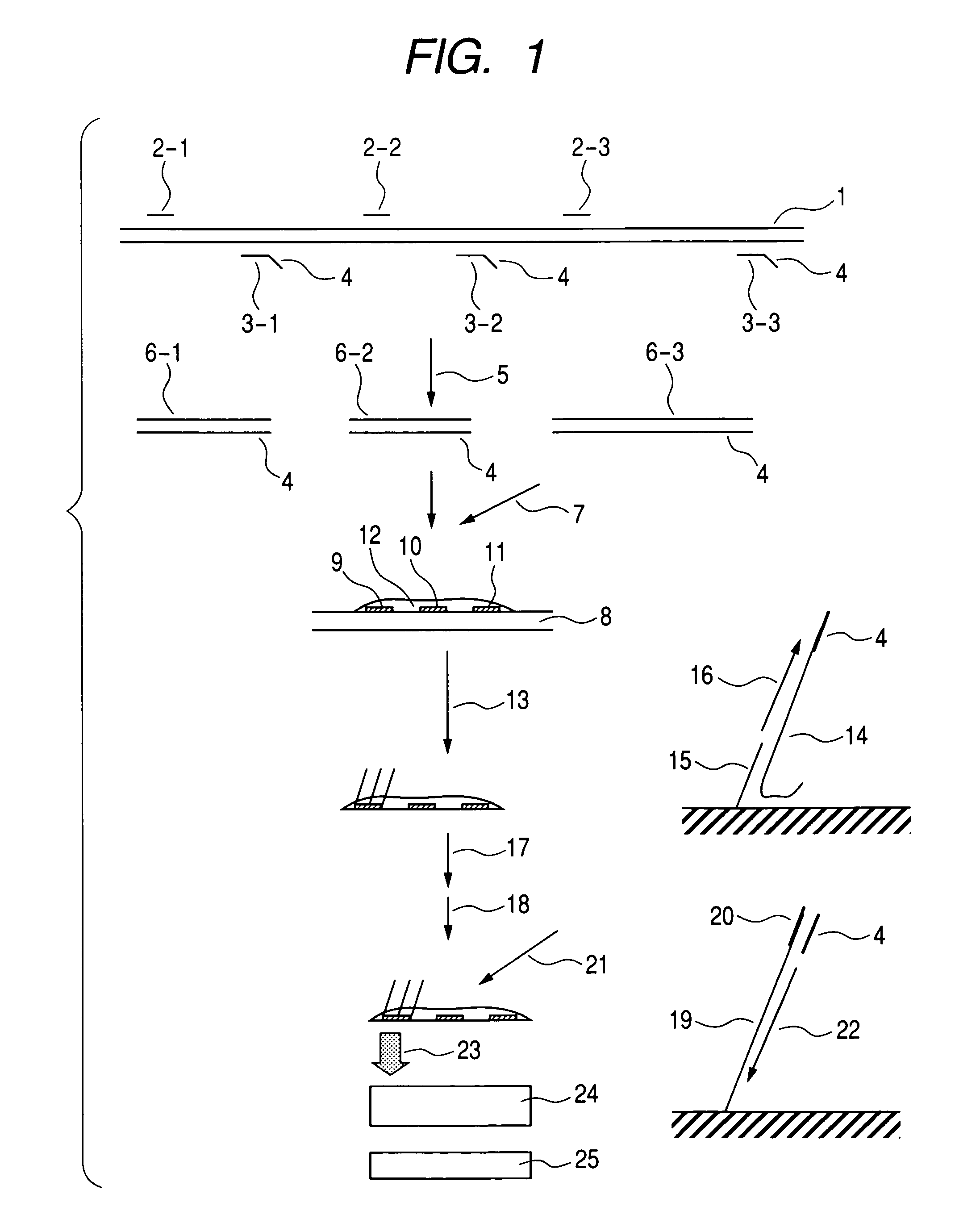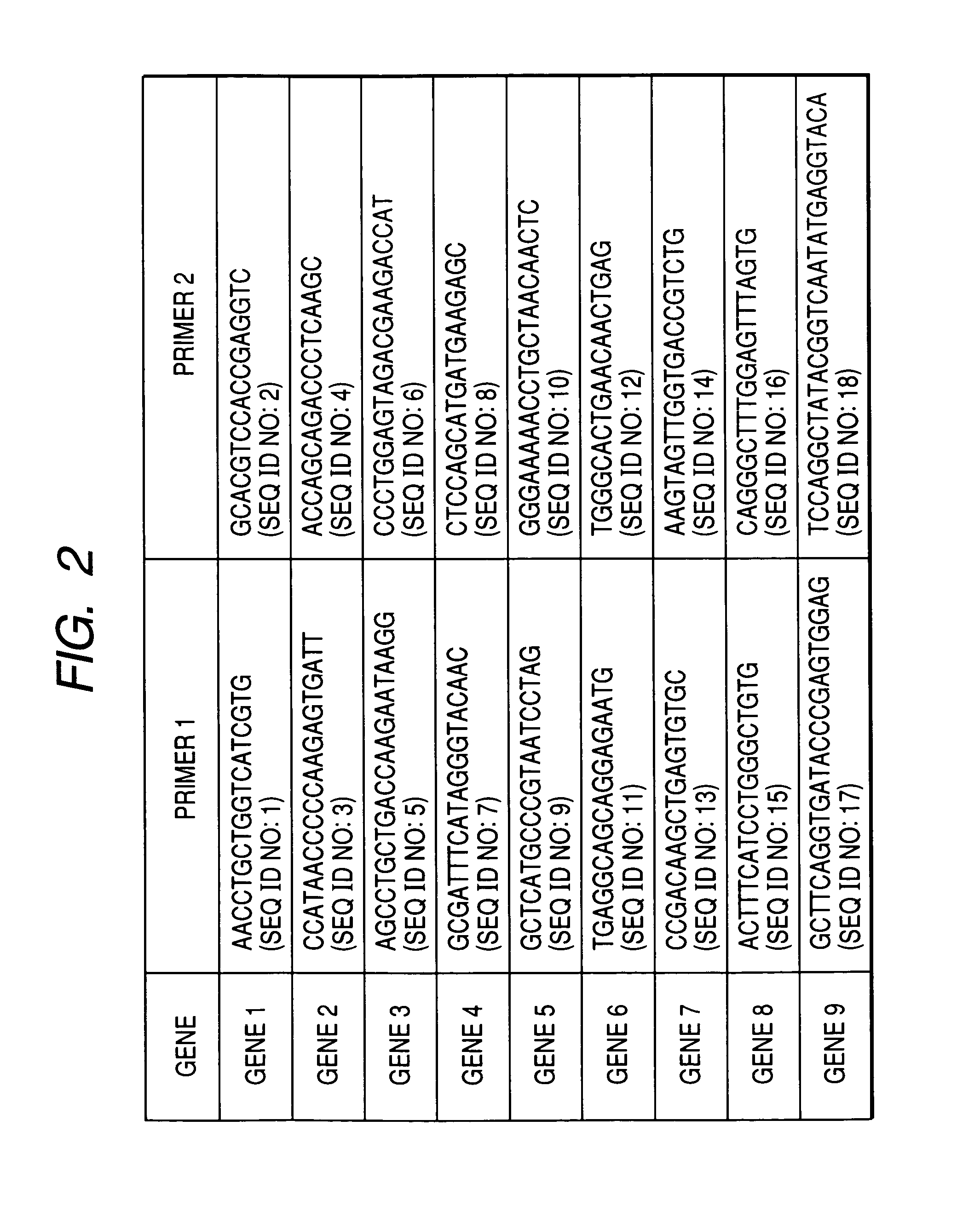Method of genetic testing
- Summary
- Abstract
- Description
- Claims
- Application Information
AI Technical Summary
Benefits of technology
Problems solved by technology
Method used
Image
Examples
example 1
[0054] Simultaneous PCR of a plurality of gene loci that employs human genomic DNA as a starting material was carried out in the following manner based on the protocol of the Multiplex PCR Kit (Qiagen). First of all, a total of eighteen types of primers (SEQ ID NOs: 1 to 18) of the primer sets having nine sets of gene-specific sequences as shown in FIG. 2 were diluted to a final concentration of 2 μM with the aid of TE buffer (10 mM Tris-HCl, 1 mM EDTA, pH 8.0). Any anchor sequence may be employed, although it should be nonspecific for the target genomic sequence. In the present example, a poly A sequence consisting of twenty nucleotides was employed as an anchor sequence and it was introduced to the 5′ end of the primer 2 shown in FIG. 2.
[0055] Master Mix (20 μl) of the Qiagen Multiplex PCR kit, 4 μl of Q-solution, 2 μl of the primer mix, 11 μl of sterilized water, and 3 μl of human genomic DNA extracted from the blood of an anonymous volunteer were added to a 96-well PCR plate, a...
example 2
[0060] The second example of the present invention is described with reference to FIG. 5. This example concerns an apparatus for detecting luminescence that is suitable for practical application of the present invention. In order to assay the ten SNP sites shown in Example 1, a chip 27 consisting of thirty detection sites 26 (each consisting of three sites) was prepared. The chip was a glass substrate, each site was a circle having a diameter of 1 mm, and DNA probe 28 was immobilized on each site. The distance between spots was 1.5 mm, and such spaces were aligned in 5 columns and 6 rows. Luminescence from 30 luminescent sites was detected from the chip bottom. A detector comprising a plurality of photodiode arrays on a silicon substrate was used. Alignment of each photodiode 29 was the same as that for the detection site on the aforementioned chip.
[0061] More specifically, photodiodes having a diameter of 1 mm were aligned in 5 columns and 6 rows at intervals of 1.5 mm. The photod...
example 3
[0062] The third example of the present invention is described with reference to FIG. 6. This example concerns a chip device that is suitable for practical application of the present invention. A chip device 34 that covers the chip regions aligned with the dimensions shown in Example 2 was prepared, and ports 35 and 36 for introducing or discharging reagents and the like were provided. The simultaneous amplification product from the genomic DNA and the reaction solution for the extension of the complementary strand were introduced to the chip device 34, the device was subjected to the thermal cycle as with the case of Example 1, and DNA probes on the chip were subjected to selective extension. After the completion of extension, the reaction solution was discharged through the outlet, a washing liquid and an alkaline solution were successively introduced through the inlet, and such liquids were discharged, thereby converting the extended DNA product on the chip to single-stranded DNA...
PUM
| Property | Measurement | Unit |
|---|---|---|
| Bioluminescence | aaaaa | aaaaa |
Abstract
Description
Claims
Application Information
 Login to View More
Login to View More - R&D
- Intellectual Property
- Life Sciences
- Materials
- Tech Scout
- Unparalleled Data Quality
- Higher Quality Content
- 60% Fewer Hallucinations
Browse by: Latest US Patents, China's latest patents, Technical Efficacy Thesaurus, Application Domain, Technology Topic, Popular Technical Reports.
© 2025 PatSnap. All rights reserved.Legal|Privacy policy|Modern Slavery Act Transparency Statement|Sitemap|About US| Contact US: help@patsnap.com



